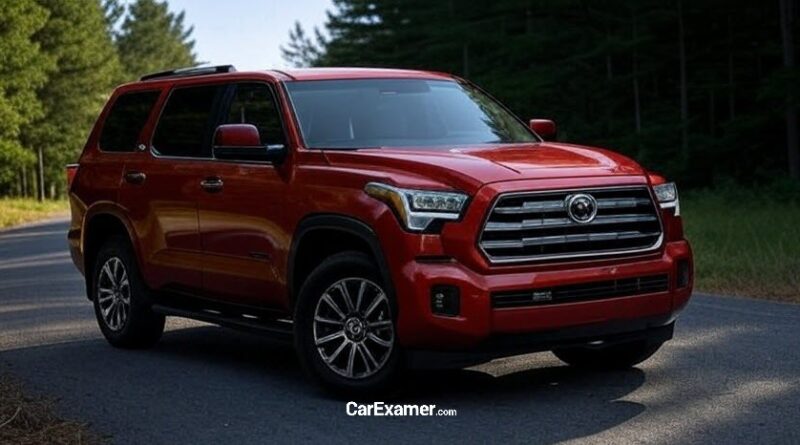Toyota Sequoia Problems Common Issues and Repair Costs
The Toyota Sequoia is a full size SUV built for families, towing, and long distance driving. It sits above the Toyota 4Runner in the lineup and competes with large SUVs like the Chevrolet Tahoe and Ford Expedition. The Sequoia is known for being tough and long lasting, but like any big SUV it does have a list of common problems that owners should know about. RepairPal lists the average annual repair and maintenance costs at about £500, while CarEdge estimates that a Sequoia will cost around £5,300 to maintain and repair over ten years. Actual expenses vary by age, mileage, and location.
Common Toyota Sequoia Problems and Repair Costs
1. Suspension and Lower Ball Joints
- Symptoms: Clunking noises over bumps, loose steering, uneven tyre wear.
- Cause: Premature wear of lower ball joints. Some earlier models even had recalls for this issue.
- Repair: Replacement of ball joints and wheel alignment.
- Cost: £160 to £400 depending on parts and labour.
2. Oxygen Sensor Failure
- Symptoms: Check Engine Light, rough idle, drop in fuel economy.
- Cause: Standard wear of oxygen sensors with age and mileage.
- Repair: Diagnostic check and sensor replacement.
- Cost: £120 to £240 depending on sensor location.
3. Engine Oil Leaks
- Symptoms: Oil spots under the car, burning oil smell, or low oil levels.
- Cause: Aging gaskets, valve cover issues, or oil pan gasket failure.
- Repair: Replace gasket or oil pan.
- Cost: £160 to £400 for a valve cover gasket. £1,000 to £1,400 or more for an oil pan repair.
4. Rust and Frame Corrosion
- Symptoms: Visible rust on frame and underbody, weakened structure.
- Cause: Road salt and moisture exposure, especially in older models. Some Sequoias had rust related recalls.
- Repair: Rust treatment, frame reinforcement, or in severe cases replacement.
- Cost: From a few hundred pounds for light rust to several thousand for heavy damage.
5. Rear Hatch and Handle Failure
- Symptoms: Rear liftgate does not open or handle breaks.
- Cause: Weak design of early plastic handles and mechanisms.
- Repair: Replace handle and linkage.
- Cost: £80 to £240.
6. Windshield and Weather Seal Leaks
- Symptoms: Water inside cabin, fogging, or wind noise.
- Cause: Poor windshield seals or aging weather strips.
- Repair: Reseal or replace the glass and trim.
- Cost: £120 to £320.
7. Engine Failure (Rare but Serious)
- Symptoms: Grinding noises, loss of power, metal debris in oil.
- Cause: Rare reports of severe failures in newer Sequoias, including engine replacements.
- Repair: Full engine rebuild or replacement.
- Cost: £3,200 to £8,000 depending on model and shop.
8. Recalls on Newer Models
- Transmission recall: Some 2023 and 2024 Sequoias may roll forward even in neutral. Fixed with a dealer software update at no cost.
- Tow hitch recall: Some hybrid models had issues with hitch covers separating. Also repaired free under recall.
Typical Repair Costs Table
| Problem | Repair Cost Range (£) |
|---|---|
| Ball joint replacement | £160 to £400 |
| Oxygen sensor replacement | £120 to £240 |
| Valve cover gasket leak | £160 to £400 |
| Oil pan replacement | £1,000 to £1,400+ |
| Rust repair | £240 to several thousand |
| Rear hatch handle | £80 to £240 |
| Windshield reseal | £120 to £320 |
| Engine rebuild or replacement | £3,200+ |
| Recall fixes | Free at Toyota dealers |
Long Term Ownership and Reliability
While the Toyota Sequoia is generally more reliable than many competitors, it is still a large and heavy SUV. That means higher running costs, more suspension wear, and expensive parts when things go wrong. Older models are most affected by ball joint failures, hatch issues, and rust, while newer models face more electronic and recall related problems.
With regular servicing and attention to warning signs, many Sequoias easily pass 200,000 miles. Budgeting around £480 to £560 a year for maintenance is realistic, but occasional larger repairs should be expected.
Final Thoughts
The Toyota Sequoia offers durability and space, but buyers should be aware of its problem areas. Suspension wear, oxygen sensors, oil leaks, and frame rust are the most common headaches, while rare but costly failures like engines and transmissions can appear in unlucky cases.
For buyers:
- Inspect the frame carefully for rust.
- Check the suspension for looseness and unusual noises.
- Confirm recalls have been completed.
- Review service history closely.
For owners:
- Stay on top of routine maintenance.
- Act quickly when warning lights appear.
- Budget for higher repair bills than smaller Toyotas.
Buying a used VW. Buying used vauxhall, BMW, Jaguar, Ford, Volvo, Range rover, Bentley, Aston Martin, Porsche, Ferrari, Lamborghini, Maserati, Hyundai, Tesla, Honda, Pagani

